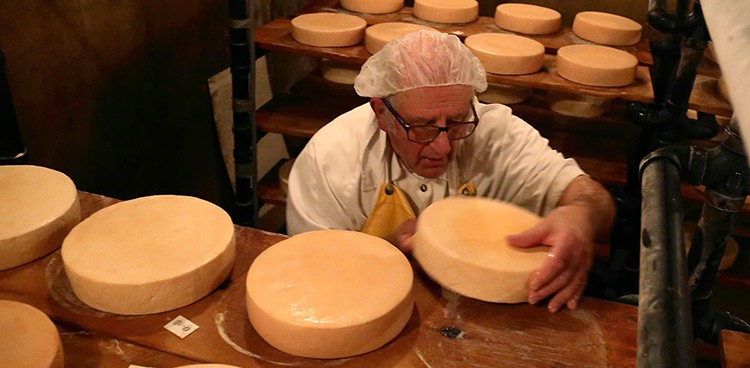
Have you ever had traditional cheese made at an actual monastery? Chances are, you probably haven’t. There are few monastic cheesemakers in the US and Canada, and they tend to sell locally, if at all. A typical monastery cheese is a semi-soft cow’s milk cheese with a washed rind. But just because a cheese is made traditionally doesn’t mean the tradition will continue. And just because the cheesemakers are nuns or monks doesn’t mean they follow medieval ideas.
Take Mother Noella Marcellino at the Abbey of Regina Laudis. Her credentials are seriously impressive: Marcellino learned some cheesemaking techniques in the 1970s, and by 1987 she had started her PhD in microbiology at the University of Connecticut. She won a Fulbright and went to France for three years, studying fungal populations in caves. And in 2002 PBS made a documentary all about her, entitled The Cheese Nun.
Marcellino puts all her knowledge to good use. She can identify all the bacteria and molds in her cheeses, none of which are taken from commercial cultures. She ages the cheese in the basement off the Abbey and identifies bacterial growth through a microscope. The Abbey makes butter, yogurt, ricotta, mozzarella, and cheddar, but perhaps their most famous product is Bethlehem. Similar to Saint-Nectaire, produced in the Auvergne region in France, Bethlehem is Marcellino’s specialty, developed taking careful note of temperature, humidity, and salinity so the bacteria are virtually identical to their French counterparts.
All of the milk the Abbey of Regina Laudis is handled by Mother Telchilde Hinckley, another nun who also earned her doctorate. She carefully tends the cows and milks them by hand each morning—there is no question of mechanizing any of their processes. The sisters at the Abbey follow the Benedictine traditon, where it is vitally important to work with your hands.
If you want to try cheese from the Abbey of Regina Laudis, you’ll have to make a trip to Connecticut. The nuns eat most of the cheese they produce and sell what little they don’t in the Abbey store. If you are able to take a year off, you could also try to win a spot in the Abbey’s internship program. A year might seem like a tall order for some of us, but the Abbey places emphasis on the quality of learning, and rushing through tasks or bowing to the pace of modern life is something that certainly doesn’t fit the character of a traditional cheesemaker.
While the process at the Abbey of Regina Laudis seems to be thriving, if modestly, the monastery Notre Dame de Prairies in Manitoba might soon see its cheesemaking tradition end. Brother Alberic, one of six monks at the monastery, is 80 years old and the resident cheesemaker. He continues to work diligently but has not yet found someone to take up his mantle. Alberic’s process of cheesemaking came to Canada in 1893, when Brother Juin of the Bellefontaine Abbey in France visited the monastery of Notre-Dame de Luc (also known as Oka Abbey). Brother Alberic started at Oka when he was sixteen and says that the secrets behind their cheesemaking technique were passed to him by a church superior. As Alberic told Modern Farmer,
“He says I want to talk to you, and he gave me an envelope. He says, keep this because you will need this later on. When I looked at it, it was the recipe of the cheese that we received in 1918 and all the letters, the exchange between the brothers of Quebec and the brothers of Manitoba.”
The most important part of Alberic’s process is washing the rinds of the monastery’s Fromage de la Trappe. He washes and flips each wheel in the cellar individually, and there are hundreds of wheels to go through. The labor is tiring and manual (Alberic himself calls it “monkey work”) but fits with the rule that he must work with his hands.
Alberic sells his cheese in the monastery cheese shop, but when he is no longer able to make the cheese, Fromage de la Trappe will cease to exist. Agropur, a Quebec-based dairy co-op, currently owns the rights to make Oka cheese, but their commercial process and pasteurized milk mean that the product won’t quite be the same.
For his part, Alberic faces his lack of a successor with a wry sense of humor. As he told Modern Farmer, “If the Lord sends somebody, so be it. If not, by the time I die, it will be the last of my problems.”
Feature Photo Credit: Max Leighton for Modern Farmer





